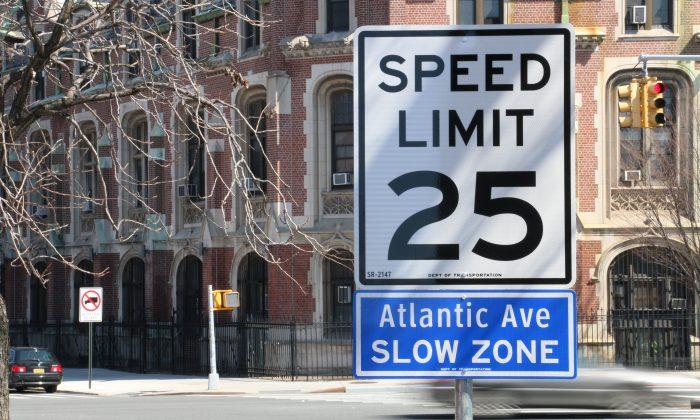NEW YORK—Nearly eight miles of Atlantic Avenue from Brooklyn to Queens, stretching from the East River to Woodhaven, will be redesigned to encourage drivers to slow down.
Transportation Commissioner Polly Trottenberg announced Wednesday the first of 25 slow zones to be installed on Atlantic Avenue by the end of April. Speed limit signs showing 25 mph will be put up, traffic lights will be retimed, and the local police precinct will further education outreach efforts.
Wide arterial roadways like Atlantic Avenue “unfortunately encourage speeding,” Trottenberg said. The traffic lights are timed to give the avenues prominence over the local streets, which also reinforces the mentality of speeding up. Therefore, the signals will be altered to allow drivers to pass through most efficiently when they drive at 25 mph.
“We want to create a street where driving at the right limit feels right,” Trottenberg said at Lowry Triangle, beside the noisy and bustling corridor.
These wide, major streets make up 15 percent of New York City roadways, but 60 percent of traffic collisions occur on these streets.
Busy Brooklyn Streets
At town hall meetings in Brooklyn, changes to Atlantic Avenue was residents’ top request. The major street runs through Central Brooklyn and is one of the city’s busiest roads.
Twenty-five traffic fatalities took place on Atlantic Avenue between 2008 and 2012. Of those, 13 were pedestrian deaths. The Tri-State Transportation Campaign rated Atlantic the third-most dangerous street in Brooklyn.
In the two-year period from 2010 to 2012, 123 pedestrians were killed on Brooklyn’s roads.
Brooklyn and Queens are often referenced as the most dangerous, and Brooklyn Borough President Eric Adams said it’s time to change that perception.
“We don’t want that title,” Adams said. “We can have free flowing arterials without senseless blood from traffic accidents.”
Previous improvements to the avenue have been incremental, like the addition of left turn lights and lengthening pedestrian crossing times.
Years of Work
The middle section of the slow zone runs through Council member Laurie Cumbo’s district. Safety was a major issue during her campaign last year.
“This is the result of years of hard work and we are really the beneficiaries,” Cumbo said. “This really shows that our voices have been heard.”
Marcia Bystryn, president of the New York league of Conservation Voters, and environmental, transportation, and community advocates led an eight-month campaign last year pushing for safety improvements on Atlantic Avenue.
“We knocked on almost 4,000 doors in City Council District 35 near the Atlantic Avenue corridor, and an overwhelming number of residents told us they wanted to see safety improvements,” stated Bystryn.
More to Come
DOT will announce the locations for the other 24 slow zones in coming weeks, with a focus on major roads across the five boroughs.
In addition to slowing Atlantic Avenue from the citywide limit of 30 mph to 25 mph, more work will be done, like corner extensions. The avenue’s redesign will count toward the quota of 50 major redesigns DOT has proposed to complete this year.
Vision Zero requires enforcement, education, and engineering, said New York Police Department transportation chief Thomas Chan. Today’s effort focuses on engineering, but the NYPD’s local precincts will follow up with enforcement and education for drivers, cyclists, and pedestrians, he said.





